| Irish Chiefs Back to Homepage |
Report on Steven L Akins, Sometimes Styled
'Akins of That Ilk' and Author of the 'Lebor Feasa Runda'

Steven Akins 'of That Ilk'
In or about the year 2000,
one Steven L Akins of Alabama advanced via the Internet a
claim to be Chief of the long neglected Akins Clan of
Scotland, going by the title 'Akins of That Ilk'. An assertion by Akins that his ancestors resided in County
Monaghan for a period before travelling to America adds an Irish
element to the story and justifies the inclusion of the case on the
present site. Akins has never received recognition as a chief from any
reputable source, and his claim was met in the main with derision,
combined with anger at his frequently expressed racist views.
Controversy raged on discussion groups such as soc.culture.scottish,
alt.scottish.clans and rec.heraldry, and at one stage a Google Groups
search returned a figure of over 10,000 items. Akins's controversial claim to
Chiefship was publicised principally on the Clan Akins
site at http://www.angelfire.com/al2/akinsclanwebsite/crest.html, but these pages were removed by the service
provider due to 'violation of terms of service'. In
2001 Steven also ran into a spot of marital difficulties,
and his wife Julie left him claiming that he had
fabricated documents and tombstone inscriptions. After a
period of silence, Akins renewed his claim to chiefship
in March 2004 on a new website http://www.geocities.com/the_clan_akins/, again no longer online.
A feature of Akins's campaign has been the sheer
volume of images of sources he has provided to back his claims. Alas,
on close examination these prove to be highly questionable. Consider
the following examples of armorial tombstones of 'ancestors' put
forward by Akins, which, it has been claimed, prove that he is a
genuine Scottish Chief:

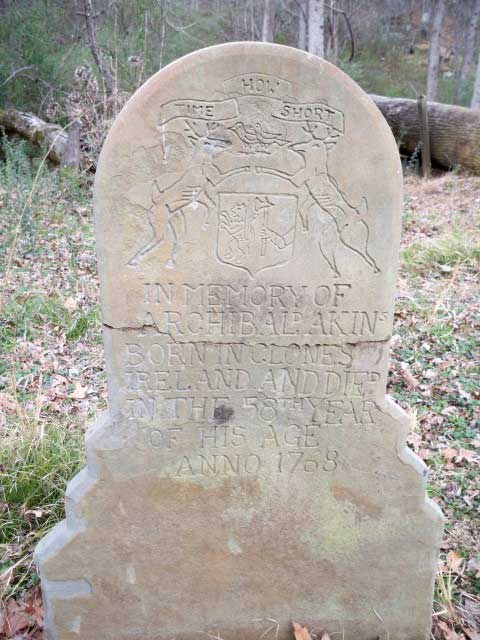
Two images of gravestone of
Archibald Akins, died 1768, claimed to be located
in Bethel Presbyterian Cemetery, Harford County, Maryland

Gravestone of
Thomas Akins, died 1785, located
in Steele Creek Presbyterian Cemetery, North Carolina
It appears reasonably certain that the 1785 memorial is
located at Steele Creek, North Carolina, as there appears to be an independent image on Find a Grave. However, analysis of
other armorial gravestones in Steele Creek Cemetery on the
newsgroup rec.heraldry
indicated that the arms on the memorials are generally either assumed
or the imaginative work of the Bigham family of headstone carvers. The
memorial to Archibald Akins died 1768, allegedly located in
Bethel Presbyterian Cemetery, Maryland, is extremely problematic. We
now have two images of this memorial as portrayed above, the first of
which has been on Find a Grave for a number of years, the second one of a series on Photobucket
to which Akins drew attention in 2011. I had previously been of
the view that the inscription on this gravestone had been added
digitally, but the clearer second image shows that it has in fact been
carved, albeit somewhat crudely. The coats of arms on the 1768 and 1785
gravestones are identical. It is remarkable that while the 1768
gravestone seems very old, the inscription appears to be remarkably
clear, indeed in places pristine. The gravestone clearly is not in the
same location or condition in the two photographs, and Akins has
claimed that it has been subject to storm damage. Efforts are
continuing to establish whether this is a genuine gravestone which has
actually been located for centuries in the Bethel Cemetery or some sort
of moveable prop. Here is another unusual looking memorial put forward
by Akins, commemorating an Alexander Akins who died in 1669 and again
fortuituously bearing the arms which Akins claims have been in his
family for years:

A still active website of Steven Akins is at http://www.genealogy.com/genealogy/users/a/k/i/Steven-L-Akins-of-that-ilk/index.html and contains images of wills and other alleged family documents of various dates. Alas, the suspicion that outright forgery is involved was confirmed following enquiries to the Maryland State Archives. There follows firstly a copy of the alleged will of Archibald Akins of Cecil County dated 1764, as presented by Steven Akins:
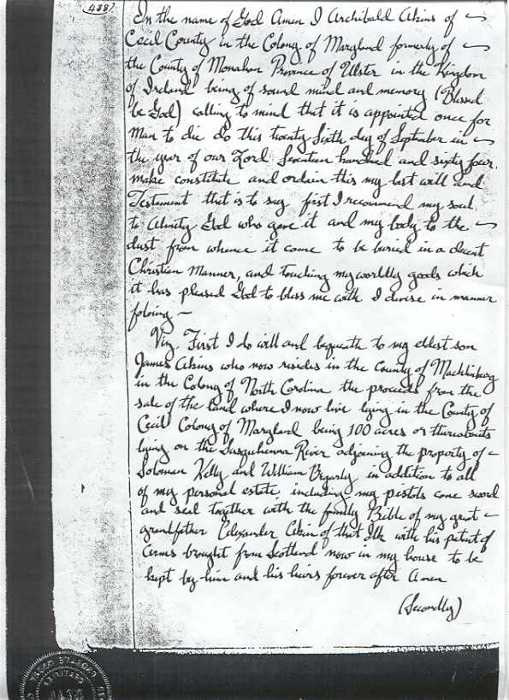
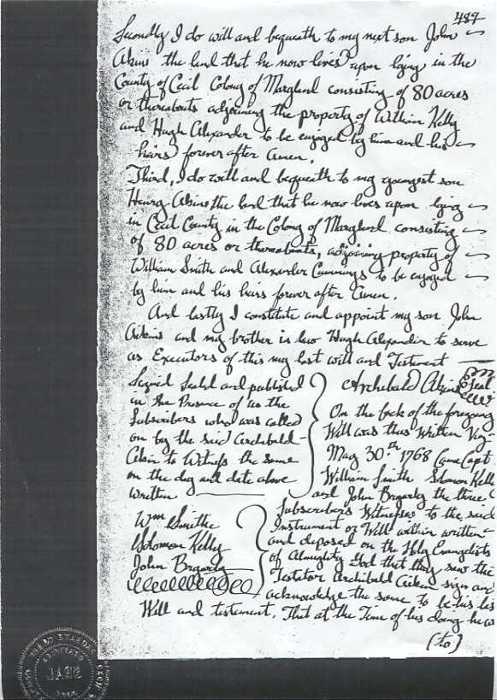
Maryland State Archives could not locate this will among its records, but did find the following strikingly similar document, being a will of Archibald Aiken of Baltimore County dated 1768:
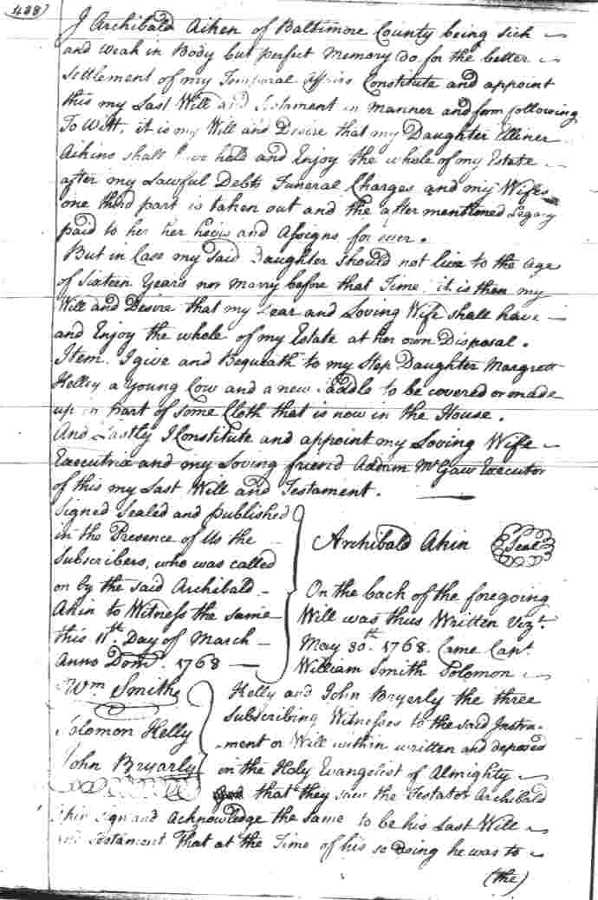
Genuine will of Archibald Aiken 1768
By using the same page number, 488, repeating the names of the three witnesses and borrowing some of the text, the forger gave himself away, showing that he had adapted a real will to his own purposes. The elements which had aroused such scepticism, namely the references to County Monaghan in Ireland and to Scotland, and the transmission of the family 'patent of arms', are now shown to be fabrications. The presence at the bottom of the pages of the alleged 1764 will of impressions of an official seal, which when reversed appear to read 'Probate Court, Cecil County', gives rise to the most serious questions. There is a further transcript of the concocted will at http://www.rootsweb.com/~mdbaltim/wills/will200.htm, where it is said to have been 'transcribed from the original copy in the Maryland State Archives by Mr. J. Barrentine'. As to other alleged wills presented online by Akins, such as those of Alexander Akins 'of That Ilk' 1669, Robert Akins 1728 and Alexander Akins 1748, the Maryland State Archives cannot locate these either, so that it would appear that these are concoctions as well.
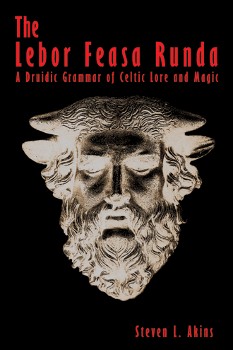
Cover of Steven L Akins's Lebor Feasa Runda
After some years of relative inactivity, Steven Akins burst upon the scene once more in 2008 with a remarkable publication entitled The Lebor Feasa Runda: A Druidic Grammar of Celtic Lore and Magic, published by iUniverse Inc of Bloomington, Indiana, a self-publishing operation which 'disclaims any responsibility' for the views of the author. Akins claims that the Lebor Feasa Runda is an ancient Irish text which had been at various times in the possession of the Knights Templar, the sixteenth-century occultist John Dee and the founder of the Illuminati Adam Weishaupt, amongst others, before eventually ending up with the Nazis and being brought to Britain by Rudolf Hess in 1941 (I kid you not). Akins fortuitously acquired his copy of the Lebor from the widow of Henry Thorenson, a World War II German officer allegedly brought as a prisoner of war to the United States, where he is stated to have settled and died in 1991 (Lebor Feasa Runda, pages xi-xviii). Akins supposedly translated Thorenson's German text into English and decided to share it with the world. Henry Thorenson has left little or no impact on the documentary record, but again very fortuitously someone has been able to locate his and his widow Evelyn's grave in Franconia Cemetery, Pickens County, by a remarkable coincidence in Akins's home state of Alabama (http://www.findagrave.com/cgi-bin/fg.cgi?page=pv&GRid=33739213&PIpi=15556309, Added by Fritz Thorenson 2/16/2009).

Thorenson memorial, claimed to be located in Franconia Cemetery, Alabama
Google searches for Henry, Evelyn and Fritz Thorenson all lead back to the above Find a Grave site or to discussions of the Lebor Feasa Runda,
with no other references to the family's existence appearing. One
cannot help noticing the similarity between the illustration of the
Thorenson gravestone and the Akins memorials portrayed above, and it
would not be unreasonable to suggest that it also may be a fabrication
(it would be useful if any interested reader of this page who resides
in or near Pickens County could check this matter).
Some of the more alert Druid revivalists have analysed Akins's Lebor Feasa Runda and found it to be not only a forgery but also heavily plagiarised from various sources (http://intothemound.blogspot.com/2009/02/creeping-druid-fakery.html). Thus we read in the opening section of Akins's text, which purports to be part of 'The Testament of Ollamh Fodhla':
And when I heard the words which were spoken unto me, I perceived that in me had the knowledge of all things, of both the mortal and immortal realms, been imparted; and I saw that all the teachings and learning of this present age were astray, and that no man was without flaw. (Lebor Feasa Runda, page xxv.)
As a matter of fact, this is clearly concocted from The Key of Solomon, an ancient grimoire or handbook of magic, as translated in the late nineteenth century by S Liddell MacGregor Mathers:
And when I comprehended the speech which was made unto me, I understood that in me was the knowledge of all creatures, both things which are in the heavens and things which are beneath the heavens; and I saw that all the writings and wisdom of this present age were vain and futile, and that no man was perfect. (http://www.esotericarchives.com/solomon/ksol.htm)
Similarly, this is part of a verse placed by Akins near the end of his book:
The wicked who would do me harm
May his throat be diseased
Globularly, spirally, circularly
Fluxy, pellety, horny-grim.
(Lebor Feasa Runda, page 148.)
This again is lifted almost verbatim from Carmina Gadelica, a collection of Scots-Gaelic folklore gathered and translated by Alexander Carmichael (1832-1912):
THE wicked who would do me harm
May he take the [throat] disease,
Globularly, spirally, circularly,
Fluxy, pellety, horny-grim.
(http://www.sacred-texts.com/neu/celt/cg2/cg2077.htm)
Displaying
remarkable impudence, Akins notes in his preface, 'Many of the
passages found in the Lebor Feasa Rúnda bear a striking similarity to a
number of traditional, centuries old, Gaelic spells and incantations
that were collected from the rural inhabitants of the Scottish
Highlands and published by the folklorist Alexander Carmichael in his
Carmina Gadelica' (Lebor Feasa Runda,
page xvi). Overall, Akins's book could be described as a strange
Irish-Scottish hybrid, with Highlands lore spliced with Irish sagas and
all overlaid with perfervid neo-paganism. Such Gaelic as Akins knows
appears to be of Scots rather than Irish hue, so that referring to the
otherworld 'Land of Youth' he writes not 'Tír na nÓg' but 'Tir
nan'Og' (page 4), a garbled version 'Tír nan Óg'. Of course Akins has
liberated himself from any need to prove scholarly command of Gaelic by
presenting his book as a translation from German, as already noted.
The core of Akins's book is clearly cobbled together from the Lebor Gabála Érenn
or Book of Invasions, presenting his versions of the familiar tales of
Partholon, the Fir Bolg, Tuatha de Danann, the Milesians and so on.
While the Lebor Gabála may
enhsrine ancient orally-transmitted myths, it is largely a work
composed by Christian monks from the eighth century onwards which seeks
to harmonise Irish and biblical chronology and converts pagan gods such
as Lugh into human figures (http://homepage.eircom.net/%7Eseanjmurphy/irhismys/milesians.htm).
Akins is obviously at pains to reverse this process and imaginatively
repaganise the narrative, so that references to Biblical figures such
as Noah are excised and the first
chapter is a somewhat unconvincing creation myth beginning, 'Long ago,
before the dawn of the ages, there was naught but the depths of a vast
emptiness which was the goddess Domnann' (Lebor Feasa Runda,
page 3). This section is probably Akins's own work and there are other
portions of the tract which read as though they may have come from his pen.
However, there are further sections which like the examples cited
above are clearly verbatim or near verbatim transcripts of the work of
others, particularly certain verse translations from the Lebor Gabála. Consider the following sample from Akins:
I invoke the land of Ireland.
Much coursed be the fertile sea,
Fertile be the fruit strewn mountain
Fruit strewn be the showery wood,
Showery be the river of waterfalls,
Of waterfalls be the lake of deep pools,
(Lebor Feasa Runda, page 79)
This is obviously taken, either directly or at second hand and with little alteration, from a version of the Lebor Gabála compiled by Macalister and MacNeill:
I invoke the land of Ireland.
Much-coursed be the fertile sea,
fertile be the fruit-strewn mountain,
fruit-strewn be the showery wood,
showery be the river of waterfalls,
of waterfalls be the lake of deep pools,
(R A S Macalister and John [Eoin] MacNeill, Editors, The Book of Conquests of Ireland, Dublin [1916], page 257)
Now
it is highly unlikely that two independent translations, one allegedly
from German, the other from archaic Irish, would produce English texts
matching so exactly.
Akins must have been aware that his more informed readers would soon realise that the Lebor Feasa Runda
was a literary
fabrication, but of course they are not the main target of the work,
which he has advertised extensively online on sites such as Druidic Dawn and Stormfront. Taking full advantage of the capacity of the Internet to
spread misinformation, Akins is addressing a credulous
constituency of assorted pagans, druids, witches, warlocks
and neo-nazis eager to believe that lost books of ancient
knowledge and magic can be recovered and employed to save the modern
world from decadence and racial impurity. There are similarities
between the Akins case and the Irish MacCarthy Mór Hoax,
in that both involve distortion and fabrication of
documents in support of an unfounded claim to chiefship. However,
while MacCarthy's spurious claims were validated by officials of the
Office of the Chief Herald in Dublin, Akins failed to secure any
kind of approval from the Court of Lord Lyon in Edinburgh. While the
Internet may be of great utility to genealogists, the Akins and
MacCarthy cases show that
it can also be abused as a medium to circulate false genealogy and
heraldry, and additionally in Akins's case, to propagate a bizarre
mishmash of Celtic mythology and racism. It is indeed a short step
from forging a pedigree to forging an entire book, so librarians, please
file the Lebor Feasa Runda under 'H' for hoax.